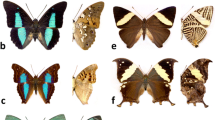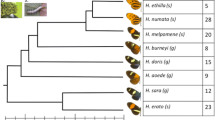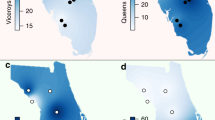Abstract
Birds are able to recognize and learn to avoid attacking unpalatable, chemically defended butterflies after unpleasant experiences with them. It has also been suggested that birds learn to avoid prey that are efficient at escaping. This, however, remains poorly documented. Here, we argue that butterflies may utilize a variety of escape tactics against insectivorous birds and review evidence that birds avoid attacking butterflies that are hard to catch. We suggest that signaling difficulty of capture to predators is a widespread phenomenon in butterflies, and this ability may not be limited to palatable butterflies. The possibility that both palatable and unpalatable species signal difficulty of capture has not been fully explored, but helps explain the existence of aposematic coloration and escape mimicry in butterflies lacking defensive chemicals. This possibility may also change the role that putative Müllerian and Batesian mimics play in a variety of classical mimicry rings, thus opening new perspectives in the evolution of mimicry in butterflies.

Similar content being viewed by others
References
Baker RR, Parker GA (1979) The evolution of bird coloration. Philos Trans R Soc Lond B Biol Sci 287:63–130
Balgooyen TG (1997) Evasive mimicry involving a butterfly model and a grasshopper mimic. Am Midl Nat 137:183–187
Barnett AA, Shaw P (2014) More food or fewer predators? The benefits to birds of associating with a Neotropical primate varies with their foraging strategy. J Zool 294:224–233
Bates HW (1862) Contributions to an insect fauna of the Amazon valley. Trans Linn Soc Lond 23:495–566
Bristow CR (1981) A revision of the brassoline genus Catoblepia (Lepidoptera, Rophalocera). Zool J Linnean Soc 72:117–163
Brower LP (1984) Chemical defence in butterflies. In: VaneWright RI, Ackery PR (eds) The biology of butterflies. Academic, London, pp 109–133
Brower AVZ (1995) Locomotor mimicry in butterflies: a critical review of the evidence. Philos Trans R Soc Lond B Biol Sci 347:413–425
Brower LP, Calvert WH (1985) Foraging dynamics of bird predators on overwintering Monarch butterflies in Mexico. Evolution 39:852–868
Brown KS Jr (1988) Mimicry, aposematism and crypsis in Neotropical Lepidoptera: the importance of dual signals. Bull Soc Zool Fr 113:83–101
Brown KS Jr, Benson WW (1974) Adaptative polymorphism associated with multiple mullerian mimicry in Heliconius numata (Lepidoptera, Nymphalidae). Biotropica 9:95–117
Burger J, Gochfeld M (2001) Smooth-billed ani (Crotophaga ani) predation on butterflies in Mato Grosso, Brazil: risk decreases with increased group size. Behav Ecol Sociobiol 49:482–492
Carpenter GDH (1941) The relative frequency of beak marks on butterflies of different edibility to birds. Proc Zool Soc Lond (A) 111:223–231
Chai P (1986) Field observation and feeding experiments on the responses of rufous-tailed jacamars (Galbula ruficauda) to free-flying butterflies in a tropical rainforest. Biol J Linn Soc 29:161–189
Chai P (1988) Wing coloration of free-flying Neotropical butterflies as a signal learned by a specialized avian predator. Biotropica 20:20–30
Chai P (1990) Relationships between visual characteristics of rainforest butterflies and responses of a specialized insectivorous bird. In: Wicksten M (ed) Adaptive coloration in invertebrates: proceedings of symposium sponsored by American Society of Zoologists. Texas A&M University, Galveston, pp 31–60
Chai P, Srygley RB (1990) Predation and the flight, morphology, and temperature of Neotropical rainforest butterflies. Am Nat 135:748–765
Cott HB (1940) Adaptive coloration in animals. Methuen, London, p 508
Dean WRJ, MacDonald IAW (1981) A review of African birds feeding in association with mammals. Ostrich 52:135–155
DeVries PJ (1987) The butterflies of Costa Rica and their natural history: Papilionidae, Pieridae, Nymphalidae. Princeton University Press, Princeton, p XXII
DeVries PJ (1999) Associations of co-mimetic ithomine butterflies on small spatial and temporal scales in a Neotropical rainforest. Biol J Linn Soc 67:73–85
DeVries PJ (2002) Differential wing toughness in distasteful and palatable butterflies: direct evidence supports unpalatable theory. Biotropica 34:176–181
DeVries PJ (2003) Tough African models and weak mimics: new horizons in the evolution of bad taste. J Lepid Soc 57:235–238
Edmunds M (1974) Defence in animals: a survey of anti-predator defences. Longman, Harlow, p 357
Endler JA, Mappes J (2004) Predator mixes and the conspicuousness of aposematic signals. Am Nat 163:532–547
Exnerová A, Landová E, Stys P, Fuchs R, Procopová M, Cehláriková P (2003) Reactions of passerine birds to aposematic and non-aposematic firebugs (Pyrrhocoris apterus; Heteroptera). Biol J Linn Soc 78:517–525
Fink LS, Brower LP, Waide RB, Spitzer PR (1983) Overwintering monarch butterflies as food for insectivorous birds in Mexico. Biotropica 15:151–153
Finkbeiner SD, Briscoe AD, Reed RD (2014) Warning signals are seductive: relative contribution of color and pattern to predator avoidance and mate attraction in Heliconius butterflies. Evolution 68:3410–3420
Fitzpatrick JW (1980) Foraging behavior of Neotropical tyrant flycatchers. Condor 82:43–57
Fitzpatrick JW (1981) Search strategies of tyrant flycatchers. Anim Behav 29:810–821
Gabriel VA, Pizo MA (2005) Foraging behavior of tyrant flycatchers (Aves, Tyrannidae) in Brazil. Rev Bras Zool 22:1072–1077
Gibson DO (1974) Batesian mimicry without distastefulness. Nature 250:77–79
Gibson DO (1980) The role of escape in mimicry and polymorphism: I. The response of captive birds to artificial prey. Biol J Linn Soc 14:201–214
Ham AD, Ihalainen E, Lindström L, Mappes J (2005) Does colour matter? The importance of colour in avoidance learning, memorability and generalization. Behav Ecol Sociobiol 60:482–491
Hancox AP, Allen JA (1991) A simulation of evasive mimicry in the wild. J Zool 223:9–13
Hespenheide HA (1973) A novel mimicry complex: beetles and flies. J Entomol A 48:49–56
Holm E, Kirsten JF (1979) Preadaptations and speed mimicry among Namib desert scarabaeids with orange elytra. J Arid Environ 2:263–271
Jenkins DW (1983) Neotropical Nymphalidae I. Revision of Hamadryas. Bull Allyn Mus 81:1–146
Kemp DJ, Jones D, Macedonia JM, Krockenberger AK (2014) Female mate preferences and male signal variation in iridescent Hypolimnas butterflies. Anim Behav 87:221–229
Kingsolver JG (1988) Thermoregulation, flight and the evolution of wing pattern in pierid butterflies—the topography of adaptive landscapes. Am Zool 28:889–912
Mappes J, Marples N, Endler JA (2005) The complex business of survival by aposematism. Trends Ecol Evol 20:598–603
Marden JH, Chai P (1991) Aerial predation and butterfly design: how palatability, mimicry, and the need for evasive flight constrain mass allocation. Am Nat 138:15–36
Martins VF, Alonço APO, Peixoto PEC, Romero GQ (2010) Are corporal allometric measurements good predictors of palatability in Neotropical butterflies (Lepidoptera)? Entomol News 121:172–185
Melo C, Marini MA (1999) Comportamento alimentar de Monasa nigrifrons (Aves, Bucconidae) em matas do oeste de Minas Gerais, Brasil. Ararajuba 7:13–15
Müller F (1879) Ituna and Thyridia: a remarkable case of mimicry in butterflies. Proc Entomol Soc Lond 1879:20–29
Olofsson M, Vallin A, Jakobsson S, Wiklund C (2010) Marginal eyespots on butterfly wings deflect bird attacks under low light intensities with UV wavelengths. PLoS ONE 5, e10798
Olofsson M, Wiklund C, Favati A (2015) On the deterring effect of a butterfly’s eyespot in juvenile and sub-adult chickens. Curr Zool 61:749–757
Penz CM, Mohammadi N (2013) Wing pattern diversity in Brassolini butterflies. Biota Neotrop 13:1–27
Pinheiro CEG (1996) Palatability and escaping ability in Neotropical butterflies: tests with wild Kingbirds (Tyrannus melancholicus, Tyrannidae). Biol J Linn Soc 59:351–365
Pinheiro CEG (2003) Does Müllerian mimicry work in nature? Experiments with butterflies and birds (Tyrannidae). Biotropica 35:356–364
Pinheiro CEG (2007) Asynchrony in daily activity patterns of butterfly models and mimics. J Trop Ecol 23:119–123
Pinheiro CEG (2011) On the evolution of warning coloration, Batesian and Müllerian mimicry in Neotropical butterflies: the role of jacamars (Galbulidae) and tyrant-flycatchers (Tyrannidae). J Avian Biol 42:277–281
Pinheiro CEG, Freitas AVL (2014) Some possible cases of escape mimicry in Neotropical butterflies. Neotrop Entomol 43:393–398
Pinheiro CEG, Bagno MA, Brandão RA (2004) Diet and foraging behavior of the rufous tailed jacamar (Galbula ruficauda, Galbulidae) in central Brazil. Ararajuba 11:89–91
Pinheiro CEG, Medri IM, Salcedo AKM (2008) Why do the ithomiines (Lepidoptera, Nymphalidae) aggregate? Notes on a butterfly pocket in central Brazil. Rev Bras Entomol 52:610–614
Pinheiro CEG, Antezana MA, Machado LP (2014) Evidence for the deflective function of eyespots in wild Junonia evarete Cramer butterflies. Neotrop Entomol 43:39–47
Poulton EB (1890) The colour of animals, their meaning and use. Especially considered in the case of insects. Kegan Paul, Trench, Trubner, London, p 360
Prudic KL, Stoehr AM, Wasik BR, Monteiro A (2015) Eyespots deflect predator attack increasing fitness and promoting the evolution of phenotypic plasticity. Proc R Soc B 282:20141531 (online version)
Rand AL (1953) Factors affecting feeding rates of anis. Auk 70:26–30
Robbins RK (1980) The lycaenid “false head” hypothesis: historical review and quantitative analysis. J Lepid Soc 34:194–208
Ruxton GD, Sherratt TN, Speed MP (2004) Avoiding attack. The evolutionary ecology of crypsis, warning signals and mimicry. Oxford University Press, Oxford, p 206
Skelhorn J, Rowland HM, Speed MP, Ruxton GD (2010) Masquerade: camouflage without crypsis. Science 327:51
Srygley RB (1994) Locomotor mimicry in butterflies? The associations of positions of centres of mass among groups of mimetic, unprofitable prey. Philos Trans R Soc Lond B Biol Sci 343:145–155
Srygley RB (1999) Incorporating motion into investigations of mimicry. Evol Ecol 13:691–708
Srygley RB, Chai P (1990a) Flight morphology of Neotropical butterflies: palatability and distribution of mass to the thorax and abdomen. Oecologia 84:491–499
Srygley RB, Chai P (1990b) Predation and the elevation of thoracic temperature in brightly colored Neotropical butterflies. Am Nat 135:766–787
Srygley RB, Dudley RB (1993) Correlations of the position of center of body mass with butterfly escape tactics. J Exp Biol 174:155–166
Stevens M (2005) The role of eyespots as anti-predator mechanisms, principally demonstrated in the Lepidoptera. Biol Rev 80:573–588
Stevens M, Hardman CJ, Stubbins CL (2008) Conspicuousness, not eye mimicry, makes “eyespots” effective antipredator signals. Behav Ecol 19:525–531
Trigo JR (2000) The chemistry of antipredator defense by secondary compounds in Neotropical Lepidoptera: facts, perspectives and caveats. J Braz Chem Soc 11:551–561
Turner JRG (1984) Mimicry: the palatability spectrum and its consequences. In: Vane-Wright RI, Ackery PR (eds) The biology of butterflies. Academic, London, pp 141–161
Tyler H, Brown KS Jr, Wilson K (1994) Swallowtail butterflies of the Americas: a study in biological dynamics, ecological diversity, biosystematics and conservation. Scientific Publishers, Gainesville, p 378
van Someren VGL, Jackson THE (1959) Some comments on protective resemblance amongst African Lepidoptera (Rhopalocera). J Lepid Soc 13:121–150
Vannin SA, Guerra TJ (2012) A remarkable new species of flesh-fly mimicking weevil (Coleoptera: Curculionidae: Conoderinae) from Southeastern Brazil. Zootaxa 3413:55–63
White TE, Zeil J, Kemp DJ (2015) Signal design and courtship presentation coincide for highly biased delivery of an iridescent butterfly mating signal. Evolution 69:14–25
Young AM (1971) Wing coloration and reflectance in Morpho butterflies as related to reproductive behaviour and escape from avian predators. Oecologia 7:209–222
Acknowledgments
We are grateful to José R. Trigo for discussions on butterfly chemical defenses and three anonymous reviewers for helpful comments on the manuscript. CEGP thanks FAPDF/CNPq/Pronex (project number 563/2009). AVLF thanks the Brazilian Research Council – CNPq (fellowship 302585/2011-7 and SISBIOTA-Brasil/CNPq 563332/2010-7), the National Science Foundation (DEB-1256742), and FAPESP (BIOTA-FAPESP Program, 2011/50225-3).
Author information
Authors and Affiliations
Corresponding author
Additional information
Edited by Fernando L Cônsoli – ESALQ/USP
Rights and permissions
About this article
Cite this article
Pinheiro, C.E.G., Freitas, A.V.L., Campos, V.C. et al. Both Palatable and Unpalatable Butterflies Use Bright Colors to Signal Difficulty of Capture to Predators. Neotrop Entomol 45, 107–113 (2016). https://doi.org/10.1007/s13744-015-0359-5
Received:
Accepted:
Published:
Issue Date:
DOI: https://doi.org/10.1007/s13744-015-0359-5




